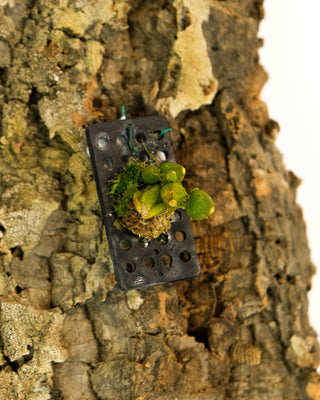Bulbophyllum comosum is a striking and unique species of orchid, known for its distinctive and vibrant blooms, making it a fascinating addition to any orchid collection. Native to the tropical regions of Southeast Asia, particularly the Philippines, this species is a part of the Bulbophyllum genus, which is one of the largest orchid genera with over 2,000 species. Bulbophyllum comosum is particularly admired for its unusual and beautiful flowers, which are often described as resembling a combination of a star and a spiky, fringed fan.
The flowers of Bulbophyllum comosum are small to medium-sized, and they feature long, thread-like petals that give the blooms a spiky, almost fiery appearance. The color of the flowers is usually a rich golden-yellow, sometimes with red or orange markings on the lip, creating a striking contrast. The lip is particularly interesting, being broad, fringed, and often curled, giving the flower a wild, tropical look. These blooms appear in clusters and have a mild, sweet fragrance that adds to their appeal.
Bulbophyllum comosum has a creeping, epiphytic growth habit, with long, slender stems and pseudobulbs that produce the flowers. The plant’s leaves are thick, dark green, and leathery, typically growing in a rosette arrangement at the base of the pseudobulbs. The overall growth form is relatively compact and low-growing, making it suitable for display in hanging baskets or mounted on pieces of bark, which mimic its natural growing environment.
This species thrives in bright, indirect light, with temperatures ranging from 65°F to 80°F (18°C to 27°C) and high humidity. Like many Bulbophyllum species, Bulbophyllum comosum prefers to be grown in a well-draining orchid mix, such as one made with bark or sphagnum moss, to ensure proper air circulation around the roots. Regular watering is important, but the plant should not be overwatered, as it can be susceptible to root rot. It is also beneficial to maintain humidity levels of 60% or higher to replicate the plant’s native tropical environment.
Bulbophyllum comosum is a striking and unique species of orchid, known for its distinctive and vibrant blooms, making it a fascinating addition to any orchid collection. Native to the tropical regions of Southeast Asia, particularly the Philippines, this species is a part of the Bulbophyllum genus, which is one of the largest orchid genera with over 2,000 species. Bulbophyllum comosum is particularly admired for its unusual and beautiful flowers, which are often described as resembling a combination of a star and a spiky, fringed fan.
The flowers of Bulbophyllum comosum are small to medium-sized, and they feature long, thread-like petals that give the blooms a spiky, almost fiery appearance. The color of the flowers is usually a rich golden-yellow, sometimes with red or orange markings on the lip, creating a striking contrast. The lip is particularly interesting, being broad, fringed, and often curled, giving the flower a wild, tropical look. These blooms appear in clusters and have a mild, sweet fragrance that adds to their appeal.
Bulbophyllum comosum has a creeping, epiphytic growth habit, with long, slender stems and pseudobulbs that produce the flowers. The plant’s leaves are thick, dark green, and leathery, typically growing in a rosette arrangement at the base of the pseudobulbs. The overall growth form is relatively compact and low-growing, making it suitable for display in hanging baskets or mounted on pieces of bark, which mimic its natural growing environment.
This species thrives in bright, indirect light, with temperatures ranging from 65°F to 80°F (18°C to 27°C) and high humidity. Like many Bulbophyllum species, Bulbophyllum comosum prefers to be grown in a well-draining orchid mix, such as one made with bark or sphagnum moss, to ensure proper air circulation around the roots. Regular watering is important, but the plant should not be overwatered, as it can be susceptible to root rot. It is also beneficial to maintain humidity levels of 60% or higher to replicate the plant’s native tropical environment.

